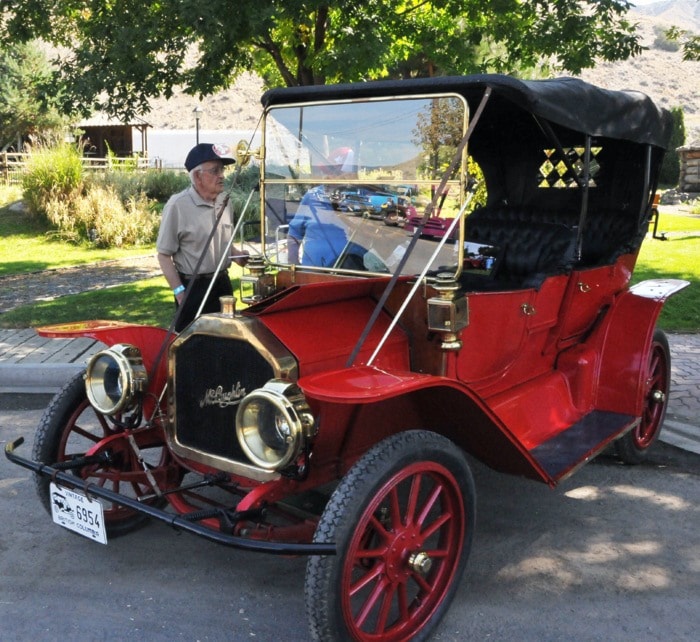by Esther Darlington MacDonald
Paved roads and highways in British Columbia came rather late. Well into the middle of the last century. That’s late, when you consider that Henry Ford’s Model T was manufactured in 1903, and the vehicle changed the transportation history of North America.
When the late Chris Hollis of Ashcroft, then the Mayor of the village, phoned “Flying Phil” Gaglardi way back in the 50s and asked the Minister to “lay some asphalt on our main street”, the good Minister sent his work crews down the five mile trail from where they were paving the Trans Canada, and they spent a few days, “laying asphalt” in quick time on Railway Avenue.
Protocol and bureaucracy had not yet taken hold to the point, obviously, as it has today. You could call the Minister as Hollis did, and say, “Hell, you are only five miles away doing asphalt, why can’t you come down here and do us a good turn?” To the very practical minded logging contractor and sawmill owner, it seemed the most sensible thing to do. And road building was synonymous with Phil Gaglardi.
B.C. was a wilderness in the 1860s. Hudson Bay trails had been cut into the B.C. interior 20 years earlier. Fur trade with the native Indians was the propulsion. Just as gold was the compelling need for transporting goods and people to the far flung reaches of Barkerville and the sundry creeks buried in the woods around the town. But those early so-called roads were little more than trails, and even with the dubious improvements that came later, when public works crews widened the trails and filled the pot holes and scraped over the gravel and moved the boulders, it took days, not hours, to get from point A to point B.
The Fraser Canyon, for instance, was a challenge right from the first. Gold seekers climbed the rocky escarpments at the risk of life and limb until the legendary Cariboo Road was built by Col. R. S. Moody’s Royal Engineers. Even then, the road through the Canyon as described by early truckers such as Andy Craig, proved the metal of every driver. Mechanized transportation didn’t get underway in B.C. until well into the middle of the 1920s. Truckers had only one lane. When another vehicle came into view, one or both vehicles had to back up until they could find a place wide enough for the vehicles to pass. You can still see the narrowness of those early highways as you are driving to Kamloops. Around the Deadman’s turn off and toward Walhachin, you can see the thin thread of asphalt that served as a “highway” well into the middle of the last century.
We drove the Fraser Canyon in 1960. Coming from the prairies, where highways were concrete and ran for miles and miles without a break, without a curve, a mountain, or a river, we found the course through the Canyon a gut churning experience. There you were, along the churning Fraser River, with rocks and dirt falling into the River, the mountains closing you in. Even paved, the Canyon highway was treacherous. Washouts and slides were commonplace.
I recall an experience closer to home. We had just come into the area, and liked to explore. We took the road to the Ashcroft slough one Sunday morning. It was 1973, or earlier. As we drove along the road, toward where the Bonaparte River meets the Thompson, the dirt road suddenly broke up before us. We were able to brake, and reverse back some distance before turning around. Now, in the sum total of history, transportation even in these parts was pretty primitive.
A recent newspaper article by Kamloops’ writer Daniel Francis noted that the Canyon highway was a “bottleneck as much as a breakthrough” because the Alexandra Bridge could only handle rigs of 30 feet in length. It wasn’t until 1949 that improvement was made with the opening of the Hope Princeton highway and the bigger trucks could go through. But Francis notes that “even the big trucks couldn’t handle the canyon until 1962 when the new Alexandra Bridge went in.”
We are accustomed today to drive on multi-laned highways of asphalt. Sure, there are still a lot of gravel roads in the interior of B.C., and not all of them can be kept up to snuff, especially in winter and spring conditions. We’ve come a long way toward providing modern transportation into the interior of the Province, given the terrain, the mountains and the gorges. Given the rivers and all the hazards to human safety the environment of this beautiful Province contains, we’ve done well.
It never fails to impress me, how well we have conquered the environment through the Fraser Canyon. Here, we have two major railroads on either side of the river, and a highway’s circuitous route through a relatively narrow canyon, mountains on either side. Your eyes want to look at the scenery, but of course, you can’t take them off the road. Only when you are able to stop, park the car and look do you realize the majesty around you.
Visitors from foreign countries driving rented RV’s never fail to park and take out their cameras. One friend of mine from Toronto, taking that route with us one summer, remarked, “This is the best kept secret in Canada.”
